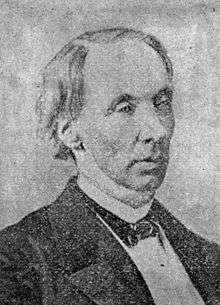Robert Dale Owen
| Robert D. Owen | |
|---|---|
|
Robert Dale Owen as he appeared in the 1840s. | |
| United States Minister to the Two Sicilies | |
|
In office 1853–1858 | |
| President | Franklin Pierce |
| Preceded by | Edward Joy Morris |
| Succeeded by | Joseph Ripley Chandler |
| Member of the Indiana House of Representatives from the 76th district | |
|
In office 1851–1853 | |
|
In office 1835–1838 | |
| Member of the U.S. House of Representatives from Indiana's 1st district | |
|
In office March 4, 1843 – March 3, 1847 | |
| Preceded by | George H. Proffit |
| Succeeded by | Elisha Embree |
| Personal details | |
| Born |
November 7, 1801 Glasgow, Scotland, UK |
| Died |
June 24, 1877 (aged 75) Lake George, New York, U.S. |
| Nationality | British-American |
| Political party |
Working Men's (1829–1831) Democratic (1832–1858) |
| Spouse(s) | Mary Jane Robinson (m. 1832; her death 1871) |
| Children |
Florence Julian Dale Ernest Rosamond |
| Parents |
|
| Religion | Spiritualism |
Robert Dale Owen (November 7, 1801 – June 24, 1877) was a Scottish-born American social reformer who was a longtime exponent in the United States of the socialist doctrines of his father, Robert Owen, as well as a politician in the Democratic Party. He served in Congress, where he successfully pushed through the Smithsonian Institution bill and served on the first Board of Regents.
Biography
Early years
Born in Glasgow, Scotland, Owen emigrated to the United States in 1825, and helped his father create the community of New Harmony, Indiana. After the community dissolved, Owen returned briefly to Europe, then moved to New York City and became the editor of the Free Enquirer, a socialistic and anti-Christian weekly, which he ran with Frances Wright from 1828 to 1832.[1]
Owen's Moral Physiology, published in 1830 or 1831, was the first book to advocate birth control in the United States (specifically, coitus interruptus).
Political career

In 1829 and 1830, Owen was an active leader in the Working Men's Party in New York City. In contrast to many other Democrats of the era, Owen and Wright were opposed to slavery, though their artisan radicalism distanced them from the leading abolitionists of the time.[2]
He returned to New Harmony, Indiana, in 1833 and served in the Indiana House of Representatives twice (1835–1838; 1851–1853). There he distinguished himself by securing appropriations for the public school system.[1] After two unsuccessful campaigns, he was elected to the United States House of Representatives in 1842, and served from 1843 to 1847. While in Washington, he drafted the bill for the founding of the Smithsonian Institution. He was on the first Board of Regents and chaired the Building Committee, which oversaw the construction of the Smithsonian Institution Building. Owen's committee selected James Renwick, Jr. as architect, Gilbert Cameron as the contractor, and the Seneca Quarry for its distinct red sandstone. In 1849, he published Hints on Public Architecture to argue the case for public buildings such as the Smithsonian Castle.[3]
Robert Dale Owen was married to Mary Jane Robinson with whom he had six children, two of whom died at an early age.[4]
Owen was elected a member of the Indiana Constitutional Convention in 1850, and was instrumental in securing to widows and married women control of their property, and the adoption of a common free school system. He later succeeded in passing a state law giving greater freedom in divorce.
In 1853, Franklin Pierce appointed Owen as United States minister to the Kingdom of the Two Sicilies at Naples.[5] After leaving that post in 1858, Owen retired from political life, but remained an active intellectual.
Ideas
During the Civil War, he served in the Ordnance Commission and the Freedmen's Bureau.[1] He wrote an open letter to President Lincoln on September 7, 1862, urging him to end slavery on moral grounds. A few days later the Emancipation Proclamation was read to the Cabinet. In March 1865, he submitted a radical initial draft of the Fourteenth Amendment that was eventually modified into the final draft.
He was a strong believer in Spiritualism and was the author of two well-known books on the subject: Footfalls on the Boundary of Another World (1859) and The Debatable Land Between this World and the Next (1872).
Death and legacy
Owen died at his summer home in Lake George, New York, and was buried in New Harmony, Indiana. The town of Dale, Indiana was named after him. In 1911, the women of Indiana dedicated a memorial to Robert Dale Owen[6] on the lawn of the Indiana Statehouse.[7]
Quotes
- 1833: The authenticity of the Bible ;
For a century and a half, then, after Jesus' death, we have no means whatever of substantiating even the existence of the Gospels, as now bound up in the New Testament. There is a perfect blank of 140 years; and a most serious one it is.[8]
See also
Footnotes
- 1 2 3
 Gilman, D. C.; Thurston, H. T.; Colby, F. M., eds. (1905). "Owen, Robert Dale". New International Encyclopedia (1st ed.). New York: Dodd, Mead.
Gilman, D. C.; Thurston, H. T.; Colby, F. M., eds. (1905). "Owen, Robert Dale". New International Encyclopedia (1st ed.). New York: Dodd, Mead. - ↑ Eric Lott, Love and Theft: Blackface Minstrelsy and the American Working Class, Oxford University Press, 1993; pg. 129.
- ↑ Peck, Garrett (2013). The Smithsonian Castle and the Seneca Quarry. The History Press. pp. 43–53.
- ↑ "The Family History of Robert Owen". Indiana University. 1923.
The children of Robert Dale Owen who reached maturity are Florence, Julian Dale, Ernest, and Rosamond, the latter being the only one of these now alive.
- ↑ "Robert Dale Owen," in U.S. Diplomatic History. U.S. Department of State, www.history.state.gov/
- ↑ Burford, William (1920). Yearbook of the State of Indiana for the Year 1919. Indiana: Legislative Bureau Division of Accounting and Statistics and The State Board of Accounts.
- ↑ "The Indiana Statehouse: A Self-Guided Tour" (pdf). Indiana Department of Administration. Retrieved 27 October 2010.
- ↑ Bacheler, Origen; Owen, Robert Dale (1833). The authenticity of the Bible. A.J. Matsell. p. 247.
For a century and a half, then, after Jesus' death, we have no means whatever of substantiating even the existence of the Gospels, as now bound up in the New Testament. There is a perfect blank of 140 years; and a most serious one it is. (Image of p. 247 at Google Books)
Works
- Moral Physiology; or, A Brief and Plain Treatise on the Population Question (1830/1)
- Labor: Its History and its Prospects (1848)
- The Policy of Emancipation (1863)
- The Wrong of Slavery (1864)
- Beyond the Breakers (1870)
- "Touching Visitants from a Higher Life," The Atlantic Monthly, vol. 35, whole no. 207, pp. 57–69.
- Threading My Way: Twenty-seven Years of Autobiography. New York: G.W. Carleton & Co., 1874.
Further reading
- Garrett Epps, Democracy Reborn: The Fourteenth Amendment and the Fight for Equal Rights in Post-Civil War America. New York: Henry Holt, 2006.
- Joshua R. Greenberg, Advocating The Man: Masculinity, Organized Labor, and the Household in New York, 1800-1840 (New York: Columbia University Press, 2008), 154-189.
- Norman E. Himes, "Robert Dale Owen, The Pioneer of American Neo-Malthusianism," American Journal of Sociology vol. 35, no. 4 (Jan. 1930), pp. 529–547. In JSTOR
- Sexson E. Humphreys, "New Considerations on the Mission of Robert Dale Owen to the Kingdom of the Two Sicilies, 1853-1858," Indiana Magazine of History, vol. 46, no. 1 (March 1950), pp. 1–24. In JSTOR
- Harlow Lindley, "Robert Dale Owen and Indiana's Common School Fund," Indiana Magazine of History, vol. 25, no. 1 (March 1929), pp. 52–60. In JSTOR
- Richard William Leopold, Robert Dale Owen: A Biography. Cambridge, MA: Harvard University Press, 1940.
- Eric Lott, Love and Theft: Blackface Minstrelsy and the American Working Class. Oxford University Press, 1993.
- Jay M. Pawa,"Workingmen and Free Schools in the Nineteenth Century: A Comment on the Labor-Education Thesis," History of Education Quarterly, vol. 11, no. 3 (Autumn 1971), pp. 287–302. In JSTOR
- Edward Pessen, Most Uncommon Jacksonians: The Radical Leaders of the Early Labor Movement. Albany, NY: State University of New York Press, 1967.
- Arthur M. Schlesinger, Jr. The Age of Jackson. [1945] Boston: Little, Brown, 1953.
- Louis Martin Sears, "Robert Dale Owen As A Mystic," Indiana Magazine of History, vol. 24, no. 1 (March 1928), pp. 15–25. In JSTOR
- Louis Martin Sears, "Some Correspondence of Robert Dale Owen," Mississippi Valley Historical Review, vol. 10, no. 3 (Dec. 1923), pp. 306–324. In JSTOR
- Oscar Osburn Winther, "Letters from Robert Dale Owen to General Joseph Lane," Indiana Magazine of History, vol. 36, no. 2 (June 1940), pp. 139–146. In JSTOR
External links
- United States Congress. "Robert Dale Owen (id: O000152)". Biographical Directory of the United States Congress.
- Owen's letter to President Lincoln.
| United States House of Representatives | ||
|---|---|---|
| Preceded by George H. Proffit |
Member of the U.S. House of Representatives from Indiana's 1st congressional district 1843–1847 |
Succeeded by Elisha Embree |
| Diplomatic posts | ||
| Preceded by Edward Joy Morris |
United States Ambassador (as Chargé d'Affaires and Minister Resident) to the Two Sicilies 1853–1858 |
Succeeded by Joseph Ripley Chandler |


